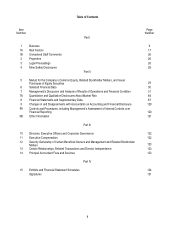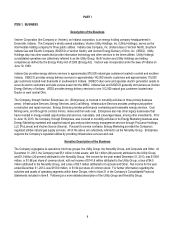Vectren 2013 Annual Report Download - page 20
Download and view the complete annual report
Please find page 20 of the 2013 Vectren annual report below. You can navigate through the pages in the report by either clicking on the pages listed below, or by using the keyword search tool below to find specific information within the annual report.
18
Corporate Risks
Vectren is a holding company, and its assets consist primarily of investments in its subsidiaries.
Dividends on Vectren’s common stock depend on the earnings, financial condition, capital requirements and cash flow of its
subsidiaries, principally Utility Holdings and Enterprises, and the distribution or other payment of earnings from those entities to
Vectren. Should the earnings, financial condition, capital requirements, or cash flow of, or legal requirements applicable to them
restrict their ability to pay dividends or make other payments to the Company, its ability to pay dividends on its common stock
could be limited and its stock price could be adversely affected. Vectren’s results of operations, future growth, and earnings and
dividend goals also will depend on the performance of its subsidiaries. Additionally, certain of the Company’s lending
arrangements contain restrictive covenants, including the maintenance of a total debt to total capitalization ratio.
Deterioration in general economic conditions may have adverse impacts.
Economic conditions may have some negative impact on both gas and electric large customers and wholesale power
sales. This impact may include volatility and unpredictability in the demand for natural gas and electricity, tempered growth
strategies, significant conservation measures, and perhaps plant closures, production cutbacks, or bankruptcies. Economic
conditions may also cause reductions in residential and commercial customer counts and lower revenues. It is also possible
that an uncertain economy could affect costs including pension costs, interest costs, and uncollectible accounts
expense. Economic declines may be accompanied by a decrease in demand for products and services offered by nonutility
operations and therefore lower revenues for those products and services. The economic conditions may have some negative
impact on spending for utility and pipeline construction projects, demand for natural gas, electricity, and coal, and spending on
performance contracting and renewable energy expansion. It is also possible that unfavorable conditions could lead to
reductions in the value of certain nonutility real estate and other legacy investments.
Financial market volatility could have adverse impacts.
The capital and credit markets may experience volatility and disruption. If market disruption and volatility occurs, there can be
no assurance that the Company will not experience adverse effects, which may be material. These effects may include, but are
not limited to, difficulties in accessing the short and long-term debt capital markets and the commercial paper market, increased
borrowing costs associated with current short-term debt obligations, higher interest rates in future financings, and a smaller
potential pool of investors and funding sources. Finally, there is no assurance the Company will have access to the equity
capital markets to obtain financing when necessary or desirable.
A downgrade (or negative outlook) in or withdrawal of Vectren’s credit ratings could negatively affect its ability to
access capital and its cost.
The following table shows the current ratings assigned to the Company and its rated subsidiaries by Moody’s and Standard &
Poor’s:
Current Rating
Standard
Moody’s & Poor’s
Vectren Corporation's corporate credit rating not rated A-
Utility Holdings and Indiana Gas senior unsecured debt A2 A-
Utility Holdings commercial paper program P-1 A-2
SIGECO’s senior secured debt Aa3 A
The current outlook for both Moody's and Standard and Poor’s is stable. The above table also reflects Moody's January 30,
2014 upgrades to each of the credit ratings shown. Both rating agencies categorize the ratings of the above securities as
investment grade. A security rating is not a recommendation to buy, sell, or hold securities. The rating is subject to revision or
withdrawal at any time, and each rating should be evaluated independently of any other rating. Standard and Poor’s and
Moody’s lowest level investment grade rating is BBB- and Baa3, respectively.
























